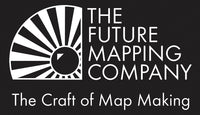Topography
THE STUDY OF PLACE
Anyone in the UK of a certain age will remember map lessons at school where we had to learn symbols to decode Ordnance Survey maps – I could never remember if a cross with a black square was a church in use or derelict. Having just checked, it would seem I learnt nothing – it’s a church with a tower as opposed to a spire!
It is this topographic information that makes a map come alive. Topography is all about detail – not only contours that show natural features, such relief above & below sea level, but also man made features such as the aforementioned church – the history & culture of a specific area.

Coming from the Greek words for ‘topos’ (place) and graphia (writing), topography is the study of place and can be said to stretch back to the earliest cave paintings where man depicted local landmarks, trees & hills, amongst tales of daring do killing bisons. Stretching forward into the empires of Greece & Rome topography focused more on the description of local history and it is in this sense that we Europeans still understand the field.
It is fascinating how so many things we see as standard information in the modern world were created not for public interest but for pure economic or political reasons. Topographic studies were often begun for military purposes.
The Ordnance Survey, the UK’s national mapping agency, is so called because the English wanted to map the Scottish highlands to enable the subjugation of the clans following the Jacobite rebellion in 1745. The OS’s military beginnings are still reflected in both its name and interestingly the War Department's broad arrow in the agency's logo. Not only did the correct maps enable us to quell Scottish uprisings but they enabled the correct taxes to be levied on villages & towns by the Government.
From the 1840’s, the OS were out in groups engaging in painstaking surveying – they developed specialist measuring equipment to enable the systematic collection of data. We’re so used to this information being available to us that we forget that it took teams of people out mapping every lump & bump in the entire country. I love the story that the head of the agency celebrated the end of each survey with a mountain top party and a plum pudding.

Topography is how we render the world we know around us and topographic symbols are vital to the order & readability of the map. Some symbols are international but so much information is so culturally specific that it’s fascinating to see how cartographers have had to develop signs & symbols differently across time & space. I love the little palm trees in this 19th century map of Baghdad which you can compare to the coniferous trees of northern Europe – our cartographers had little use for a palm tree symbol!

Some Topographic symbols are almost childishly hand written – it’s hard to see why this continues in our technological era when everything could be digitally rendered but I love that it reminds us of a time centuries ago when someone (like the four generations of the Cassini family who succeeded in mapping the whole of france) had to stand, measure & hand draw what they saw.
Some cartographers took drawing to another level such as the hand drawn landform maps of the Hungarian Erwin Raisz which were so intricate and enabled him to modify the symbols to take account of any landscape. Interestingly this approach highlights a split between traditional & computer mapping – a digital map wouldn’t be able to show this level of variation, perhaps showing a limitation to how modern maps enable us to see the world.

Another issue is that topographic symbols have to be continually redefined as the world changes around the maps – I love the new OS wind turbine symbols. And what about needing a map when the topography is rapidly changing such as in the World Wars? Heavy gunfire would have obliterated previous land forms making navigating change almost on a daily basis, not to mention moving troops. Now we have computers that can continually update but in the past they had to develop military symbols that were laid over maps as their armies marched:
If only they’d explained it to me this way at school and I might have paid more attention!



